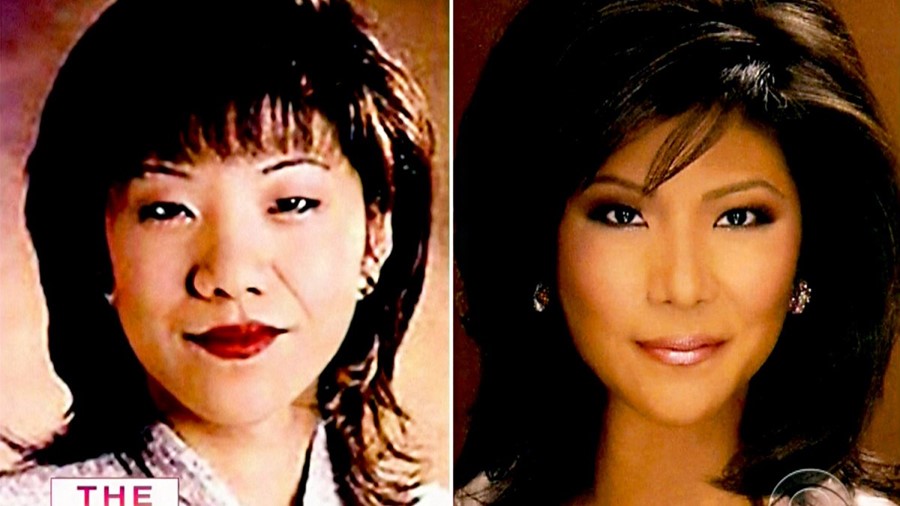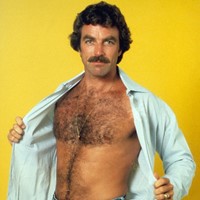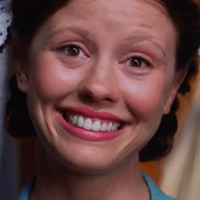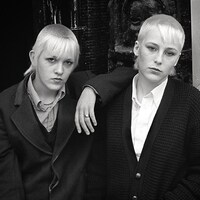From celebrity culture to propaganda-like advertising, we examine the relationship between Western beauty ideals and the popularity of double eyelid surgery in Asia
The relationship between double eyelid surgery and race is a complex one. Back in 2007, Tyra Banks invited Liz, a Chinese-American woman, on her show to talk about her double eyelid surgery. Banks accused her guest of “ethnic tweaking” to make herself look wide-eyed and Caucasian, despite Liz’s protests that it was merely to prevent her eyes from drooping. Then there is the infamous story of Julie Chen in the 90s, the Chinese-American television personality who underwent double eyelid surgery after her boss said she’d never make it as a top news anchor because her eyes made her look “disinterested” and because she was Chinese.
In 2017, an estimated 1.3 million people worldwide underwent double eyelid surgery, according to a report by the International Society of Aesthetic Plastic Surgery. The procedure is particularly popular in Asia, where it is the most commonly requested surgery. In Japan, for example, 187,000 eyelid procedures were done in 2017 – well over the amount of every other surgical procedure combined (roughly 107,000).
Around 50 per cent of Asians are born without a visible eyelid crease above their lash line (meaning they have monolids). In 1896, Japanese surgeon Mikamo developed the procedure known as blepharoplasty in order to address this, believing the double eyelid to be “more attractive”. “The double eyelid creation is a fairly common procedure,” says Singapore’s leading plastic surgeon, Dr Ivor Lim. “It’s usually performed on what we call ‘Mongoloid Orientals’ (Chinese, Korean, Japanese…). Anatomically, this eyelid has an extra fold of skin called the epicanthus in addition to the low position where the eyelid skin is adherent to the underlying structures, combined, these features give the appearance of a ‘single’ eyelid. Some orientals have the ‘Western’ eye to begin with and do not have a prominent epicanthus.”
There are two ways to perform the 30-minute double eyelid surgery. First is the closed thread/suture technique where simple stitches are used to create a depression in the skin. Second is the open incision technique, which creates a more intricate design. It is important to note that this surgery is also performed on people with natural double eyelids, to either increase eyelid exposure, make them symmetrical, or tighten the skin where the eye starts to sag. It costs about £2000-£6000 (depending on what anaesthetic you choose and the complexity of the surgery).
“Demand for the procedure has historically been pegged to a desire to look more Western.”
Demand for the procedure has historically been pegged to a desire to look more Western. In the 1960s, Dr David Millard, a pioneer of plastic surgery, published a series of articles in academic journals on how patients living in post-war South Korea were opting for surgery because they “wished to look more like the American troops, or aspired to the foreign sense of aesthetics”. Fast forward to South Korea today, and “corrective” double eyelid surgery has been normalised simply as a way of becoming more attractive. Advertisements for the procedure with slogans like “pretty girls all know” and “just like my mother’s choice” are plastered all over the city, including on public transport, with an almost propaganda-like feeling to them. In fact, the procedure has become an integral part of growing up, with parents offering it to children as a reward for academic achievement, or even as a gift following high school graduation and before they start applying for jobs as many Koreans believe that success is dependent on looks. According to the South China Morning Post, millions of young people in China undergo double eyelid surgery “to help them get a job (and) be happy”.
Celebrity culture is another influencing factor, with numerous K-drama stars and K-pop singers getting the surgery. In an interview about his surgery, singer Kyuhyun said the procedure was “suggested by my label… to have a more soft impression”, while singer Shindong admitted his “double eyelid surgery increased the number of my fans”. In a 2012 Vice documentary, a group of Korean girls admitted to wanting to look like “pretty Western celebrities”, while K-pop singer Miss Duboc from band D-Unit she said surgery would create an “ideal appearance (which) would be that of westerners.”
The representation of a “perfect face” with double eyelids encouraged by the media and unavoidable avertisting has lead the public, not only in Korea but throughout Asia, to believe that reaching these “ideal” beauty standards will result in their success just like their idols, and improve both their social and work lives.
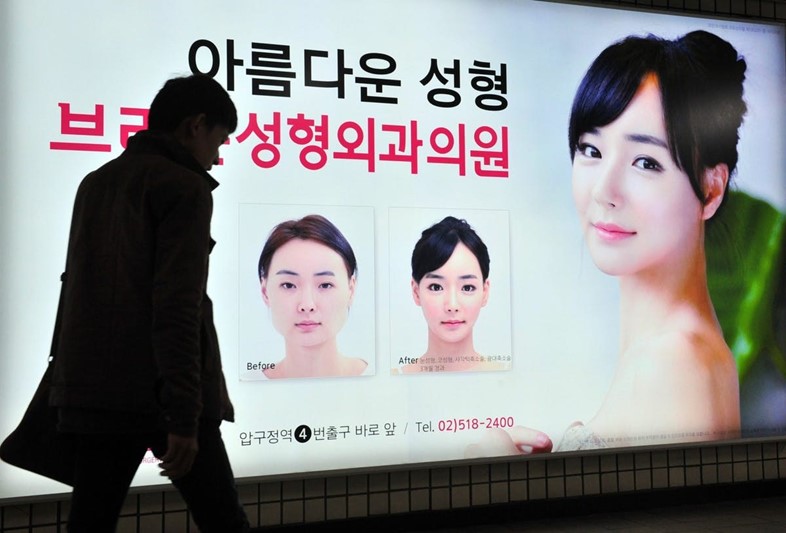
When asked about why he believes the procedure is so popular, especially among Asians, Dr Lim says that clients often get “the surgery to better define the eyelids which otherwise appear low. As a result of the surgery, there is a nice frame to the eye which also makes it look more attractive. A nice crisp fold also allows for better make-up application.” This is something which resonates with 20-year-old Hong Kong native Hailey, for whom growing up with monolids was an insecurity. “In the beauty world, tutorials are barely ever tailored for Asian features,” she says. Following her surgery last year, however, Hailey believes she has “a more universal eye shape, which makes applying any type of make-up and any beauty technique easier.”
But not everyone opts for surgery in order to fit wide-eyed Western beauty ideals. Take Margaret, for example, a 21-year-old from China but now based in Melbourne, who chose to have the surgery for physical concerns. Throughout Margaret’s teen years, she started to feel her eyelids were beginning to sag: “I had to start lifting my forehead in order to open my eyes,” she says. After undergoing surgery at 19, she is pretty pleased: “My eyelids aren’t huge or unnatural looking. It fixed the droopiness.” Which, despite Tyra Bank’s accusations, is the same reason her guest gave back in 2007 for undergoing the procedure. “My eyes were starting to sag,” she told Tyra. “I was looking tired. I didn’t have that youthful look.”
Then there’s Kiki, a 22-year-old student from Seoul living in London who had the surgery when she was 20. “Eyelid surgery is a personal preference,” she says, “different people like to highlight different parts of their face. Some focus on their skin, their lips, their eyebrows. I wanted to be comfortable having no make-up and still feeling wide-eyed and confident. I don’t know if growing up with Eurocentric beauty standards have anything to do with this.”
But for some, the pressure of Eurocentric beauty ideals, which dominate mainstream media, cannot be ignored. Dr Eugenia Kaw, published author and doctorate of Anthropology analyses how cultural perspectives have influenced the way Asian Americans view beauty. In her book, Medicalization of Racial Features she explores the belief that Asian American women undergo plastic surgery to change their natural features which they believe lack emotion, and are therefore considered to look dull and lacklustre.
“Growing up in London as a Chinese-Malaysian, I often experienced discriminating comments about my eyes such as “can you see as much as a white person can?””
One doctor she spoke to attributes the rise in blepharoplasty to “exposure to Western culture” which has ultimately led to a cultural “realisation that the upper eyelid without a fold tends to give a sleepy appearance, and therefore a more dull look.” Which is something Julie Chen noted. Despite apologies issued to her from Ohio TV station, whose racist comments had led her down the path of surgery, she ended up thanking her plastic surgeon on The Talk for making her look “more alert”.
The kind of microaggressions inflicted on Julie is something a lot of people of East Asian descent have experienced. Which is one of the reasons we look to emulate Western beauty ideals, as a means of fitting in. Growing up in London as a Chinese-Malaysian, I often experienced discriminating comments about my eyes such as “can you see as much as a white person can?” This made me very aware of the appearance of my eyes and how they differed from other people’s. However, I have been lucky enough to surround myself with an open-minded and diverse group of friends who all celebrate one another for our differences. I have never felt pressure to have blepharoplasty (also partly because I am very queasy about the idea of surgery in general). However, I regularly wear false eyelashes to open up my eyes and make them more appealing as a focal point of my face, which is probably due to the same reason my friends have opted for surgery. It’s not so much about looking ‘Western’, rather looking more attractive. But perhaps the two cannot be divorced?
Whether people are modelling themselves after Western-looking eyes or just trying to look more “alert”, we can’t ignore the fact that numbers are growing. Obviously what people do with their body is a personal decision and should be accepted, however when people are being pressured into looking a certain way, it becomes a problem. To challenge this, we must confront media representations and societal definitions of beauty. Now is the time that we need to be seeing images of women with all eye shapes celebrated, as a reminder that there is no such thing as a fixed beauty.
